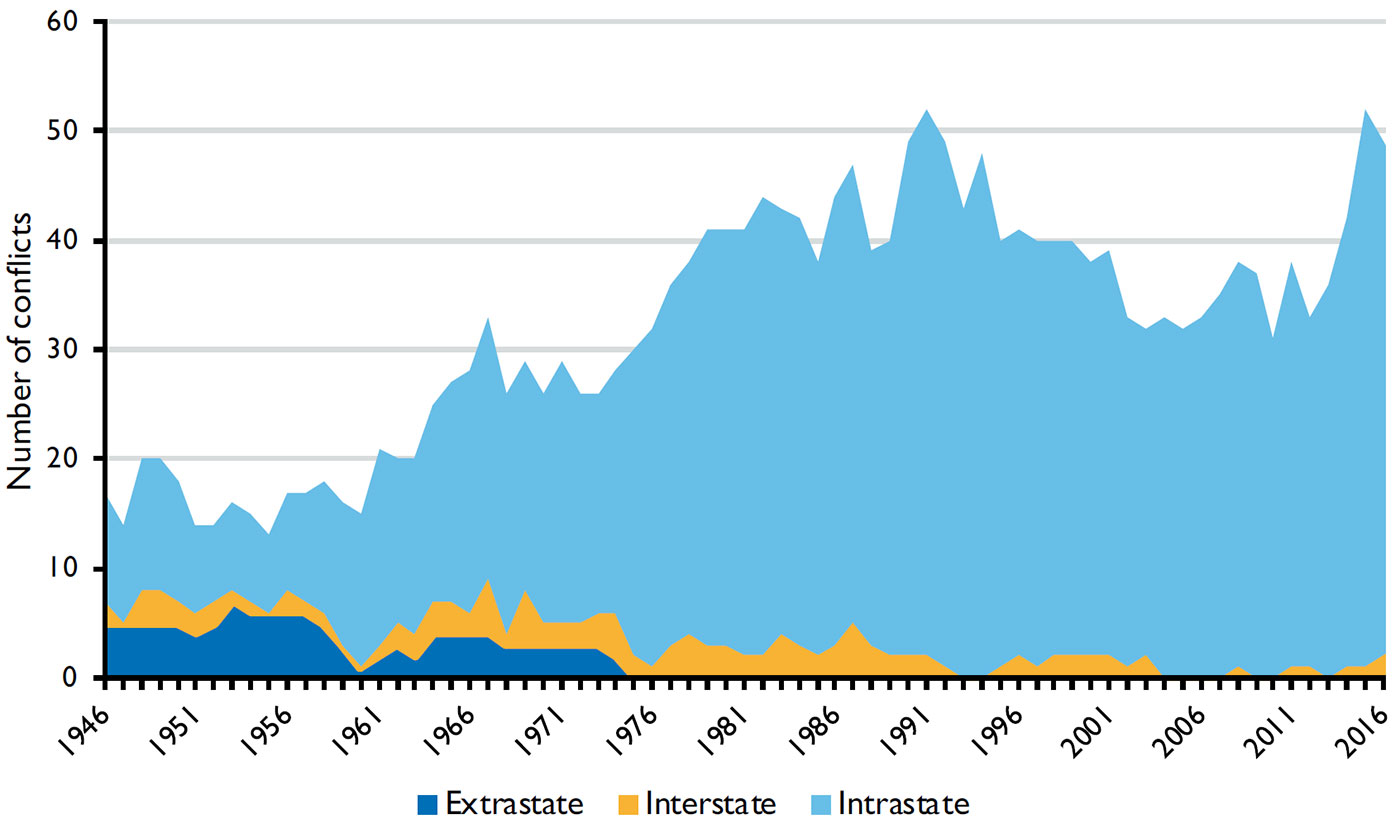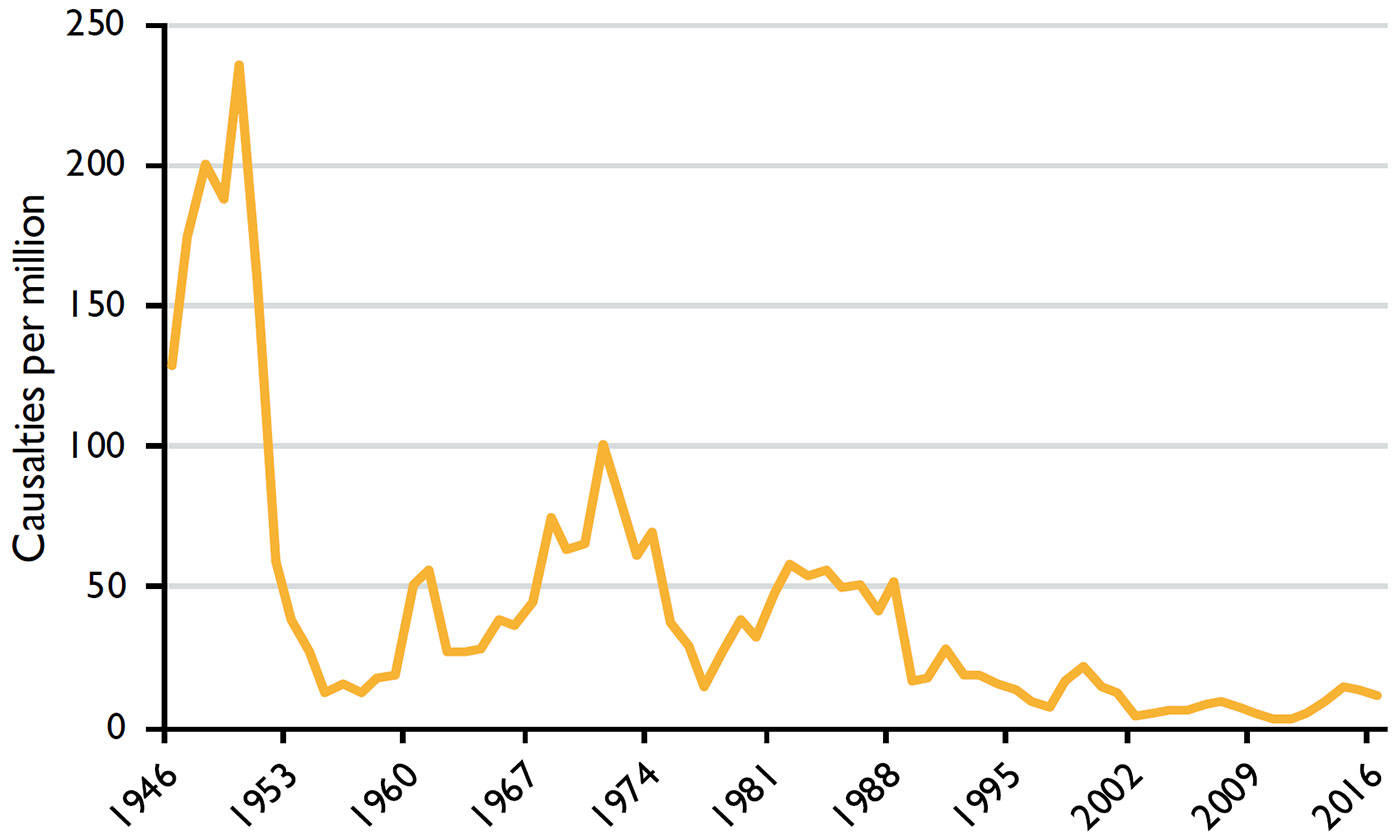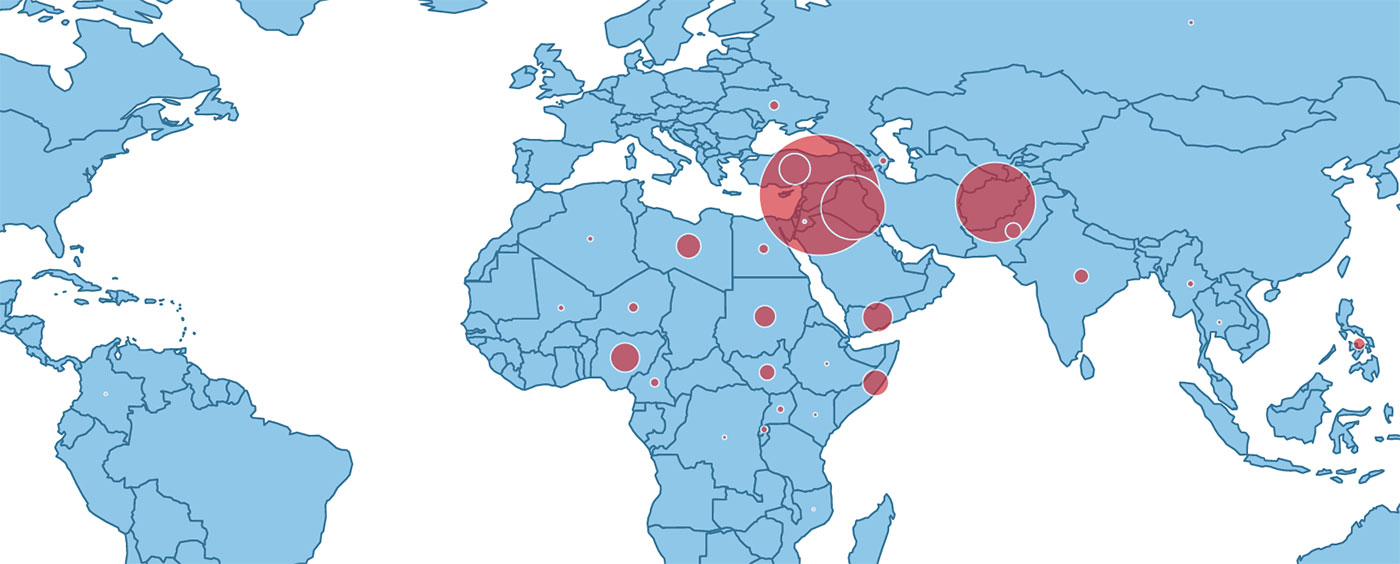By Kendra Dupuy, Scott Gates
 As its title suggests, this brief highlights the number of conflicts and battlefield deaths that have occurred in the world since 1946. The text´s authors note, for example, that 1) the number of armed struggles in the world declined slightly from 52 in 2015 to 49 in 2016; 2) 14 percent fewer people died in 2016 as a direct result of violent conflicts than in 2015, and 22% fewer than in 2014; and 3) the internationalization of organized violence continues apace, which consequently makes such clashes longer lasting and more difficult to solve.
As its title suggests, this brief highlights the number of conflicts and battlefield deaths that have occurred in the world since 1946. The text´s authors note, for example, that 1) the number of armed struggles in the world declined slightly from 52 in 2015 to 49 in 2016; 2) 14 percent fewer people died in 2016 as a direct result of violent conflicts than in 2015, and 22% fewer than in 2014; and 3) the internationalization of organized violence continues apace, which consequently makes such clashes longer lasting and more difficult to solve.
2016 was the fifth most violent year in the world since the end of the Cold War. While violence levels were lower than in 2014 and 2015, ongoing conflicts with serious regional impacts are challenging the international community’s ability to ensure global peace.
Brief Points
There was a decline in battle casualties in 2016. 14% fewer people died in 2016 as a direct result of conflict than in 2015, and 22% fewer than in 2014.
The number of armed conflicts in the world declined slightly from 52 in 2015 to 49 in 2016.
The internationalized conflicts in Syria, Iraq, and Afghanistan have the highest number of casualty levels globally.
The trend in the increasing internationalization of conflicts is concerning, as these conflicts, on average, last longer, are more violent, and are more difficult to solve.
Recent Trends
The number of armed conflicts in the world in 2016 was 49 according to the Uppsala Conflict Data Program (UCDP). Over 102,000 people were killed as a direct consequence of armed conflicts in 2016, a decline from 131,000 in 2014 and 119,000 in 2015. Yet, the level of violence currently seen is higher than any other time in the post-Cold War period, with 2016 the fifth most deadly year on record since 1989.
Since the end of the Cold War, the trend in armed conflict has been generally downward, as seen in Figure 1. Yet in recent years, we have seen upsurges in both the number of conflicts and in the severity of war. Does this portend an end to the waning of war?
The total number of conflicts increased from 41 in 2014 to 52 in 2015, and decreased only slightly to 49 in 2016. The number of wars – conflicts with more than 1,000 battle deaths – increased from 11 in 2015 to 12 in 2016. The two conflicts that passed the threshold to war (1,000 battledeaths) – Syria-IS and Somalia-Al Shabaab – became significantly more violent in 2016. The number of minor armed conflicts (25,999 battledeaths) decreased from 41 to 37, a decrease of 4 conflicts from 2015.
The twelve wars in 2016 accounted for 94% of all battle deaths, whereas the 37 minor conflicts accounted for only 6% of the total. There is stability in the pattern of the largest conflicts: Of the twelve wars, nine were also categorized as wars in 2015. Yemen, Iraq, Nigeria, Syria, Afghanistan, and Somalia had continuations of ongoing wars in 2016. Syria represented 46% of the world’s battle deaths in 2016, Afghanistan 21%, and Iraq 13%. Casualty numbers decreased in Ukraine, South Sudan, and Pakistan to the point where they are no longer considered to be experiencing war but rather minor armed conflict. Sudan, Turkey, and Libya joined the list of countries experiencing war in 2016. Concerningly, violence levels nearly tripled in Turkey. Violence declined significantly in Nigeria, Pakistan, Ukraine, and Yemen, although Yemen and Nigeria in particular remain highly deadly conflicts.
Many internal armed conflicts continue to be internationalized: of the 47 intrastate conflicts in 2016, external states contributed troops to at least one of the sides in 18 of them (38%). The increasing internationalization of conflicts in the past few years is worrisome as such conflicts, on average, last longer, are more violent, and are more difficult to solve.

Trends in Conflict
The Uppsala Conflict Data Program (UCDP), the leading provider of statistics on political violence, has identified 280 distinct armed conflicts since 1946. This includes all organized military conflict over government or territory involving one or more state government(s) and causing at least 25 battle-related fatalities in a year. Figure 1 displays the number of conflicts around the world by type and year since 1946. Two trends over the long term are immediately detectable.
First, colonial and interstate conflicts, which accounted for half of all armed conflict early in the period, have waned. Today, the predominant form of conflict is internal to a state, although quite often involving external state actors.
The second trend is the distinct rise in the number of civil conflicts, peaking in 1991, followed by a decline. 1991 witnessed 52 armed conflicts, in contrast to 2003 with 32. Since 2003 the number of armed conflicts has risen and fallen, ranging between 30 and 52.
This pattern of rising and falling numbers is simply due to the onset of new conflicts set against the number of conflicts that end. The steep decline in conflicts from 1992 to 2003 was due to fewer conflicts starting anew than the number ending. The accumulation of conflicts over the course of the Cold War resulted from more wars starting than ending. To further reduce the number of conflicts in the world today, not only must we work to resolve the on-going conflicts, but we must also try to prevent others from starting.
Battle casualties do not follow the same pattern as the number of armed conflicts. Figure 3 on the next page shows the number of battle deaths per million in the world (UCDP and PRIO data). (The per capita comparison controls for the growing global population.) The number of battle casualties peaked in the early 1950s. Despite the low number of conflicts, this period contained some of the most deadly wars in the post–World War II era, notably the Chinese Civil War (1946–1949) and the Korean War (1950–1953). Wars, such as Vietnam, Iran-Iraq, Afghanistan, DRC, and Ethiopia-Eritrea account for the subsequent peaks. The general pattern is one of decline, with each peak falling short of its predecessor. The small rise in battle casualties evident today results mostly from the civil war in Syria.
Islamic Extremism
Utopian ideologies are a potent threat to peace. In the previous century, fascism and communism were the main obstacles to peace. Today, political Islam presents the gravest challenge.
Figure 2 to the left summarizes the 87,000 people killed in armed civil conflict over the past year. The colors in the graph differentiate between conflicts, with varieties of blue indicating that at least one party is affiliated with some strand of political Islam. A large proportion of conflict-related casualties are occurring in conflicts involving Islamic State (IS), including Syria, Afghanistan, and Iraq. Organized violence across all IS-related conflicts increased from 39,100 in 2015 to 41,300 in 2016. The greatest increase in IS-related violence occurred in Syria, Turkey, Libya, and Afghanistan. Syria is the deadliest war since the end of the Cold War. Since 2012, about half of all war casualties around the world have occurred in this country. The exponential increase in violence in Turkey is due to the IS-related conflict there, as well as to the conflict in Kurdistan, which reached more than 1,000 battle deaths.
Daesh Allegiance
 The main reason for the strong increase in the number of conflicts over the past few years is the proliferation of local Islamic groups that now pledge allegiance to the Daesh (also known as Islamic State). Conflicts involving Daesh in a conflict dyad took place in 12 countries in 2016, the same number as in 2015, but with two new conflicts: Afghanistan, Cameroon, Egypt, Iraq, Jordan, Libya, Niger, Nigeria, Pakistan, Russia, Syria and Yemen. Jordan and Pakistan were recorded as new IS conflicts, while the IS conflicts in Chad and Lebanon of 2015 did not pass the 25 battle deaths threshold to be counted as minor conflicts.
The main reason for the strong increase in the number of conflicts over the past few years is the proliferation of local Islamic groups that now pledge allegiance to the Daesh (also known as Islamic State). Conflicts involving Daesh in a conflict dyad took place in 12 countries in 2016, the same number as in 2015, but with two new conflicts: Afghanistan, Cameroon, Egypt, Iraq, Jordan, Libya, Niger, Nigeria, Pakistan, Russia, Syria and Yemen. Jordan and Pakistan were recorded as new IS conflicts, while the IS conflicts in Chad and Lebanon of 2015 did not pass the 25 battle deaths threshold to be counted as minor conflicts.
These conflicts and organizations were active prior to 2015, so the number of conflicts reflects primarily the shifting orientation of these groups from toppling governments to establishing ‘Islamic Caliphates’. For example, the conflict in West/Central Africa involving Boko Haram, which has now pledged allegiance to Daesh, was counted as one conflict in 2014. In 2015 it was split into six conflicts: four involving Daesh in Cameroon, Chad, Niger and Nigeria, and two involving Boko Haram in Cameroon and Nigeria prior to the group changing its allegiance to Daesh. Five of these conflicts were also active in 2016, all except in Chad.
Thus, while the number of conflicts is concerning, we are not witnessing a spread of conflict to many new geographical areas, or a proliferation of entirely new conflicts, but rather the rise of new actors and motivations for conflict.
Has the Waning of War Ended?
The general increase in the number of conflicts is neither a blip nor a trend, but something in between. Only a small pool of countries exhibits any significant likelihood of becoming embroiled in war. For these countries, latent conflict is ever present, ready to escalate to minor armed conflict, or to war.
 Since World War II, this pool of candidates has shrunk. Every year some portion of these candidates will experience war or minor armed conflict. The portion involved in fighting thus determines the upswings and downswings in conflict trends. The severity of these conflicts, and whether they continue, is shaped by a number of factors, including: the number of actors involved in the conflict, their relative strength, the type of warfare, the nature of foreign intervention, and porous borders. Given these factors, we should expect to see the wars in Syria, Iraq, Afghanistan, Pakistan, Ukraine, and Yemen to continue into the near future.
Since World War II, this pool of candidates has shrunk. Every year some portion of these candidates will experience war or minor armed conflict. The portion involved in fighting thus determines the upswings and downswings in conflict trends. The severity of these conflicts, and whether they continue, is shaped by a number of factors, including: the number of actors involved in the conflict, their relative strength, the type of warfare, the nature of foreign intervention, and porous borders. Given these factors, we should expect to see the wars in Syria, Iraq, Afghanistan, Pakistan, Ukraine, and Yemen to continue into the near future.
The bubbles on the map above show where most deaths due to civil war occurred in 2016. Presently, this is one of the indicators proposed to track progress along target 1 of Sustainable Development Goal number 16: “Significantly reduce all forms of violence and related death rates everywhere”.
Large bubbles represent substantial battle casualties associated with civil war. Small dots represent armed conflict with low levels of battle casualties. Several large red overlapping bubbles can be seen in the Middle East. Given the number of actors involved in these wars, plus foreign intervening powers, the porous borders, and relative force levels of belligerents, the wars in Syria and Iraq are likely to continue to take their toll in years to come.
Despite these negative trends, there are signs of hope for some of the most long-lasting, intractable conflicts. A peace agreement was finally signed in Colombia in 2016 with the main rebel group, FARC, and the government is currently negotiating a separate agreement with a second rebel group, the ELN. Battle deaths have declined dramatically in the country. Violence has also declined in one of the main conflicts in the Philippines (Mindanao), and overall conflict-related deaths have declined in the country.
For the next five years, we should expect to see the number of conflicts in the world to remain somewhere between 30 and 40. Since the 1950s, the number killed in warfare has generally declined. Since 1992, just after the end of the Cold War, the number of armed conflicts in the world fell continuously. Since 2013, we have seen a rise in both the number of conflicts and in battle casualties. Nationalism and religious extremism lie behind much of this uptick. In the short-run, we should not see major changes in conflict trends. Despite ongoing conflicts, in the broader Middle East in particular, we can expect the longer-term trend in the decline of war and battle deaths to continue as democratization and development proceed. Yet there is still an urgent need to invest in both conflict resolution and prevention efforts so as to ensure that the march towards global peace continues.
No comments:
Post a Comment